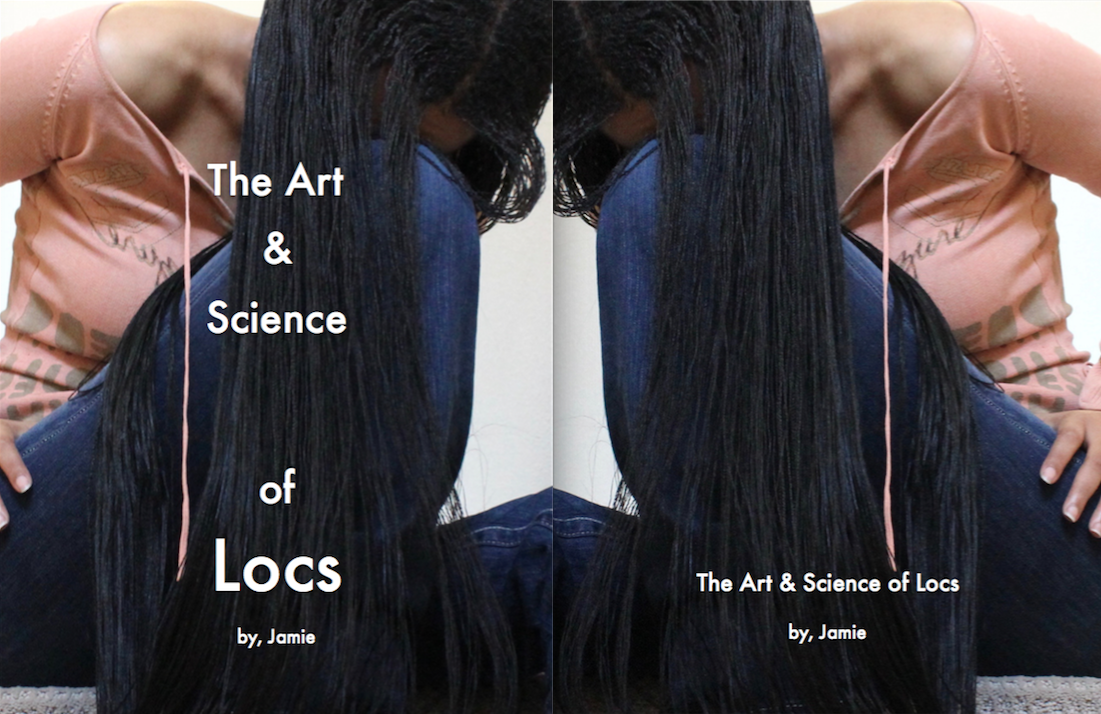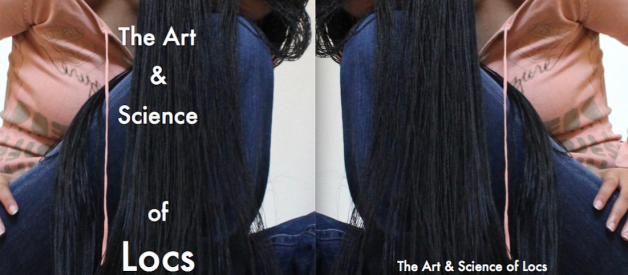 front and back cover of The Art & Science of Locs, scheduled publish date March of 2016
front and back cover of The Art & Science of Locs, scheduled publish date March of 2016
Disclaimer: Below is a rough draft of an excerpt from an upcoming book entitled, The Art & Science of Locs. This excerpt has not been edited for spelling, grammar, or word-flow so the content and structure may change before final publication. At this time we?re requesting help with editing related to all of the aforementioned as well as the historical facts listed herein. If you?re interested in helping out with this project, please get in touch with us at [email protected]. You can also get in touch with the author via DM on Twitter @ScientistPilot DMs are open to non-followers. If you?re familiar with Rastafarian culture and have something to add, we?d like to hear from you.
The History of Locs Many people are aware of the stereotypes that popular culture has attributed to ?dreads? and locs, but few are aware of the true origins of the style or of what the style actually means to the people who wear it for cultural or religious reasons. In this chapter I?m going to explore the history and cultural meaning behind the various different types and styles of locs, and touch on what some might consider a sensitive topic, cultural appropriation, and how it?s given locs, commonly referred to as ?dreads?, a bad name. Whenever someone asks me about the history of locs, or as many still call them, ?dreadlocks? they?re almost always interested in finding out who started rocking the style first. When black people ask me this, they?re usually trying to assert cultural ownership over the style, and when white people ask me this, they?re typically trying to obtain some sort of external evidence that it?s okay for them to rock ?dreads? ? the thought process being that if black people don?t own ?dreads? then black people technically can?t object to white people rocking them (more on that later). Interestingly, it?s not exactly straight forward to find information on the origin of locs. If you do a quick google search you?ll find various articles from various sources, but few of those sources can be considered academic authorities on the history of ?dreadlocks?, and even fewer still quote any references at all, likely because it?s very difficult to find freely available academic resources to read, either in print or online, which is just one example of why I am such a strong advocate for open access to academic knowledge and primary sources, (but I digress). Fortunately, despite my difficulty finding authoritative information online, I was lucky enough to come across several useful and authoritative books in my research. One such book, entitled The Encyclopedia of Hair, A Cultural History3, was especially useful. From that book I managed to obtain the following information:
According to The Encyclopedia of Hair, A Cultural History, the oldest historical record of an African tribe rocking locs can be credited to the priests of the Ethiopian Coptic religion, who were wearing the style as early as 500 BCE. Heading on over to India, the earliest historical reference of locs comes from 1800 BCE (and the credit goes to the Hindu holy men called the sadhus). There is also evidence of Ancient Egyptians rocking locs as well as various African tribes, such as the Maasai of Kenya (who have been rocking locs for only God knows how long).
Sadly, it?s difficult to pin down an official date for the origin of locs in Africa. Thanks to colonialism and other acts of violence, much of the history of non-white ethnicities and cultures has been completely lost. We?re told that the majority of African history was passed down through oral tradition, meaning that much of it was eroded and thus lost as European ?scientists? began to gather ?evidence? for the pseudoscientific ideology related to the ancient Greek belief in the ?Great Chain of Being?4, that eventually resulted in white supremacy, the slave trade, and the widely accepted view that Africans and other black and brown skinned people are part of a ?sub-human? class and thus not worth respecting or acknowledging.
So what does this have to do with ?dreadlocks?? It?s clear if you take a look at history that nobody owns ?dreadlocks? but if you really want to get technical about things, nobody really owns anything that can be attributed to some other culture or group of humans at least at one point along the historical timeline, and since we all originated from the same group of people in Africa, I guess everything that everyone has ever invented is fair game to claim by all members of the human race.
The aforementioned approach to cultural identity would be fine in a world where dominant cultures did not exist, but since we live in a world where the dominant culture is Western culture, we have to be careful that we don?t slide down the slippery slope of cultural appropriation. Thus while it is technically accurate to say that someone from all human cultures must?ve rocked locs at some point in time, it?s only fair to give due credit to the people whose cultural practices embraced locs as a major part of their culture as well as those cultures and people who made locs into the popular hairstyle that they are today.
As such, the real question here is where did the modern interest in locs manifest? To answer that question we have to take a look at the history of Jamaica. Locs or ?dreadlocks? became popular there somewhere around the 1930s to 1950s. From The Smithsonian ?Perhaps the most familiar feature of Rastafari culture is the growing and wearing of dreadlocks, uncombed and uncut hair which is allowed to knot and mat into distinctive locks. Rastafari regard the locks as both a sign of their African identity and a religious vow of their separation from the wider society they regard as Babylon?5
Some historians attribute Jamaican interest in locs to the Howellites who settled in Jamaica between 1942 and 1954. Other historians attribute the style to East Indian slaves, and others to the Kenyan Mau Mau warriors whose image and history were influential in the formation of several afrocentric movements in Jamaica, but more recent work ? based on the author?s personal encounter with sources from the various political and social groups of Jamaica around the time of the adoption of ?dreadlocks? ? suggests that ?dreadlocks? actually appeared in Jamaica, with cultural significance, when adopted by the Youth Black Faith somewhere around the 1940s.6
From Rastafari & Other African-Carribean Worldview: ?They elected to wear their hair matted, like the outcasts from society, because not only where they treated thus, but they did not consider themselves part of it.? The author goes on to further justify his conclusion by saying ?In bringing this chapter to an end, I need to point out that the position that I have presented does support Horace Campbell, except in one respect. While we concur that ?dreadlocks? was a phenomenon of the 1950s, not prior, he nevertheless maintains that it was adopted in keeping with the warrior image of the Mau Mau, whereas I have argued that it was adopted in keeping with the lunatic image of the outcast.?6
Regardless of how locs became popular in Jamaica, it?s clear that the culture of locs is still evolving. If we fast forward to the present, many people rocking locs, who incidentally hail from all races, aren?t doing so because they want to make a political statement or because they want to firmly establish themselves as outcasts ? separate from society ? but rather because they either like the look (i.e. to them locs are a fashion statement) or because they?re opting to rock locs as a protective style for their natural hair (i.e. locs are becoming an important part of cultural grooming practices for those with afrotextured hair).
So who owns ?dreads? and locs? As briefly touched on before, the ideal answer to that question is no one, but a more realistic answer to that question would be, the people who rock the style for religious reasons, cultural reasons, or out of necessity (i.e. those who adopted locs as a means to maintain and care for their afrotextured hair). Unfortunately this means that people of European decent who are rocking locs may find themselves guilty of what many would call cultural appropriation, unintentionally or otherwise.
The problem with cultural appropriation is simply that, when white people adopt hairstyles, forms of dress, or other aspects of minority culture, they have the power to change the popular meaning of that style, item, or practice within the larger mainstream culture. This can be damaging to members of the minority culture, who are then penalized, stereotyped, and discriminated against while engaging in their cultural practices as a result of a false narrative created by members of the majority culture, who have in essence hijacked the minority culture and changed its significance and meaning in mainstream media, and thus in the eyes of people outside of the impacted minority culture world wide.
For example, when it comes to ?dreadlocks? the most common stereotype is that people who wear locs are lazy, dirty, stoners. A vivid example of this is found in the comments made by Giuliana Rancic of E!?s Fashion Police. When 18 year old Zendaya Coleman sported faux-locs on the red carpet, Rancic said ?I feel like she smells like patchouli oil ? or weed.?
Rancic later apologized for her statement and pointed out that in her opinion, it had ?nothing to do with race?7, but unfortunately Rancic couldn?t be more wrong. The stereotypes surrounding locs have everything to do with race and racism, namely the fact that the appropriation by whites of non-white cultural practices can have a long-lasting and truly damaging impact on how those cultural practices are seen and interpreted by mainstream media thereafter. Sure Rastas smoke weed, but the adoption of the ?dreadlocks? (which have been worn by black and brown people as part of culturally significant practices since the dawn of time) was about defying oppressive social norms and rebelling against Western standards of beauty reducing that to people who rock ?dreadlocks? must ?smell of weed? is exactly what cultural appropriation looks like, which is exactly why it is a form of erasure and violence against minority cultures by the majority.
Does that mean that white people shouldn?t be able to rock ?dreadlocks?? No, of course not, but it does mean that mainstream media ought to have some respect for the minority cultures from which the ?trendy? amongst the majority are borrowing. The best way to have respect for minority cultures is to have equal representation for those cultures in the media. If those who borrow from a culture are the only ones who can write the narrative for said culture then many things will be lost in translation, intentionally or otherwise.
If mainstream society understood more about Rastas (the modernizers of ?dreadlocks?) and the natural hair movement (a different, but equally important source for a cultural perspective about locs and other traditional hairstyles invented by people with afrotextured hair) then white people rocking ?dreadlocks? wouldn?t result in Rastas and people with afrotextured hair being denied employment, access to an education, or otherwise discriminated against as a result of rocking locs.
No ?dreadlocks? policy sends Oklahoma black girl home from school ?in tears?8. The school told this little black girl that she was not ?presentable?. Her crime, not living up to Western standards of beauty. This is yet another example of the damage caused by cultural appropriation, which is itself a result of racism and erasure. Imagine for a moment what would happen if a little white girl attended a predominantly black school and was sent home for wearing her hair in a pony-tail, or for not wearing her hair in an afro (despite the fact that her hair cannot be easily placed in a style that lends itself to afrotextured hair). That?s essentially what happened to another little black girl who was told she?d be expelled from school if she did not straighten her hair 10.
The afro pictured above on the right is optional but the afro pictured above on the left is not. Conforming to Western standards of beauty costs black women with afrotextured hair billions of dollars a year, and results in damage to the hair, scalp, and most importantly ? the soul.
So, while some white people who rock traditionally black hair styles will often say things like ?it?s just hair? or ?black people don?t own? afros, braids, dreads ? whatever, it?s important to remember that for black people with afrotextured hair, it?s not just about hair, it?s about survival, it?s about social standing, it?s about access to jobs and education, it?s about access to a normal life.
To better understand why, we have to take a look at white supremacy, slavery, and the institutions that followed. Black women and men are made fun of (and even fired from their jobs) for rocking short hair9?10, and for rocking fake hair, and for rocking their natural hair in protective styles such as locs, braids, and twists. If you don?t have natural afrotextured hair then you might not know that it often takes an entire day to wash, condition, and care for afrotextured hair when opting to rely on heat and other styling methods to achieve straight hair (i.e. to conform to Western standards of beauty without chemicals). If you have afrotextured hair and you do opt for chemicals to straighten your hair (i.e. to conform to Western standards of beauty) you will either spend a small fortune on products to keep your hair healthy and straight, or you will suffer from dry, damaged, brittle hair that looks unnatural and breaks if you so much as look at it in the mirror.
Many black men and women who are tired of this regime opt to either shave off all of their hair (a much more viable option for black men than black women in today?s society) or they choose to adopt traditional African hairstyles that provide protection from the elements and ease of styling. Thus these traditionally black styles are much more than fashion statements for those who wear them.
For me, my locs and the braids I rocked before them, provide me with the freedom to live an active lifestyle and to do the things that I want to do. Now I don?t have to take an entire day out of my already busy schedule to wash my hair (and if you?re a pilot, martial artist, mechanic, chemist working in a lab ? enter whatever other ?dirty? job here ? you?re going to have to wash your hair often).
With locs and braids I can wash my hair and go ? daily if necessary ? a luxury that is readily available to those with naturally straight hair, but that only manifest for people like me if and when we take matters into our own hands, go against Western standards of beauty, and embrace the traditional styles of our ancestors.
References:


